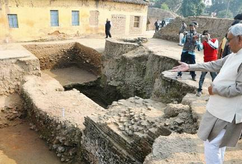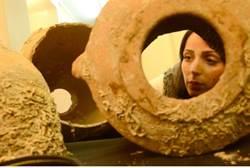INSTITUT SUPERIEUR D'ANTHROPOLOGIE
INSTITUTE OF ANTHROPOLOGY
ONLINE COURSES / COURS A DISTANCE
SPRING TERM : APRIL 2014
REGISTER NOW
ROYAUME UNI -  Broxmouth - Archaeologists have identified the earliest use of steel in the British Isles from a site in East Lothian. They now believe artifacts recovered from the site of the Broxmouth Iron Age hill fort were made from high-carbon steel. This would have been deliberately heated and quenched in water, indicating "sophisticated blacksmithing skills". The steel objects were manufactured in the years 490-375BC. Because of their condition, it has not been possible to say definitively if the objects were tools, weapons, or served some other purpose. The Broxmouth site was in use from the Iron Age until the period of Roman occupation, nearly 1,000 years later. The near-total excavation of the area in the 1970s means it is almost entirely gone, with a cement works in its place. The new research was carried out on objects recovered at that time. Well-preserved roundhouses, elaborate hill fort entrances and an exceptionally rare Iron Age cemetery were among the discoveries made at the site.
Broxmouth - Archaeologists have identified the earliest use of steel in the British Isles from a site in East Lothian. They now believe artifacts recovered from the site of the Broxmouth Iron Age hill fort were made from high-carbon steel. This would have been deliberately heated and quenched in water, indicating "sophisticated blacksmithing skills". The steel objects were manufactured in the years 490-375BC. Because of their condition, it has not been possible to say definitively if the objects were tools, weapons, or served some other purpose. The Broxmouth site was in use from the Iron Age until the period of Roman occupation, nearly 1,000 years later. The near-total excavation of the area in the 1970s means it is almost entirely gone, with a cement works in its place. The new research was carried out on objects recovered at that time. Well-preserved roundhouses, elaborate hill fort entrances and an exceptionally rare Iron Age cemetery were among the discoveries made at the site.
http://www.bbc.co.uk/news/uk-scotland-edinburgh-east-fife-25734877
INDE -  Telhara- Archaeologists have traced the remains of another university at Telhara, about 40 km from the ancient Nalanda University, a reference to which was found in the account of Chinese travellers Hiuen Tsang and Ithsing. The remains of the university in Nalanda district were found during the course of an excavation at Telhara, Director state Archaeology Atul Kumar Verma told PTI. The excavation, which began at Telhara in Ekangalsarai block of Nalanda in 2009, was still continuing. Verma said there was a reference to the Telhara university in the travel account of Ithsing, who had visited Nalanda, a distinguished centre of learning in Bihar, in the 7th century A.D. The account suggested that Telhara was either a seat of higher research or a competitor to Nalanda university, he said. Verma, who is also Director of the excavation at the site, said there was an account of three Buddhist temples at Telhara in Ithsing's account which were found during the excavation. Besides, the account mentioned a big platform on which around 1000 Buddhist monks used to sit for prayer, he said. ;A similar platform has been located during the excavation, he said.
Telhara- Archaeologists have traced the remains of another university at Telhara, about 40 km from the ancient Nalanda University, a reference to which was found in the account of Chinese travellers Hiuen Tsang and Ithsing. The remains of the university in Nalanda district were found during the course of an excavation at Telhara, Director state Archaeology Atul Kumar Verma told PTI. The excavation, which began at Telhara in Ekangalsarai block of Nalanda in 2009, was still continuing. Verma said there was a reference to the Telhara university in the travel account of Ithsing, who had visited Nalanda, a distinguished centre of learning in Bihar, in the 7th century A.D. The account suggested that Telhara was either a seat of higher research or a competitor to Nalanda university, he said. Verma, who is also Director of the excavation at the site, said there was an account of three Buddhist temples at Telhara in Ithsing's account which were found during the excavation. Besides, the account mentioned a big platform on which around 1000 Buddhist monks used to sit for prayer, he said. ;A similar platform has been located during the excavation, he said.
Verma said evidences of both Gupta and Pala period structures, like the one mentioned by Chinese traveller Hiuen Tsang, have also been unearthed at Telhara.
http://www.business-standard.com/article/pti-stories/after-nalanda-another-university-remains-found-in-bihar-114011500712_1.html
CHINE - Weiqiao- The Shaanxi Provincial Institute of Archaeology said on Tuesday that seven ancient bridges were unearthed in the past two years at a site in Weiqiao, Xi'an, famous for its centuries-old relics, xinhuanet.com reported. According to staff members of the institute, the bridges date back to between the late Warring States Period (475-221 BC) and the Tang Dynasty (AD 618-907). One of the bridges, made of wood and featuring beam columns, was at least 15.4 meters wide and 880 meters long. It is the largest such bridge discovered anywhere. In April 2012, the Weiqiao relics were discovered by local villagers on the south bank of Weihe River in Xi'an. Archaeological excavations are currently under way at the site.
http://www.ecns.cn/2014/01-15/97035.shtml
ISRAËL –  Poriya Illit - It started with a phone call from Osnat Lester, a resident of Poriya Illit, to the Israel Antiquities Authority (IAA). “Stored in my warehouse,” she said, “there are crates full of ancient jars that were left behind by a relative, a fisherman, who has passed on. I want to hand over the jars to the state, but it is important for me that my grandchildren will know where they will be kept in the future.” Two archaeologists were dispatched to Lester's home, where they were astounded to discover a real archaeological treasure: numerous whole ancient jars – or amphoras – from different eras, wrapped in bedsheets and pieces of cloth. The jars had apparently been carried by ancient ships that sank at sea at different eras. They were covered by a layer of encrustation that includes sea shells and chalk sediment, as is typical of findings that have been on the sea floor for a long time. One of the amphoras was an impressive Biblical era jar from about 3,000 years ago, the archaeologists said. Other jars were from the Roman and Byzatine eras. The IAA commended Lester for her act of good citizenship and promised that the jars would be placed on display for viewing by the general public.
Poriya Illit - It started with a phone call from Osnat Lester, a resident of Poriya Illit, to the Israel Antiquities Authority (IAA). “Stored in my warehouse,” she said, “there are crates full of ancient jars that were left behind by a relative, a fisherman, who has passed on. I want to hand over the jars to the state, but it is important for me that my grandchildren will know where they will be kept in the future.” Two archaeologists were dispatched to Lester's home, where they were astounded to discover a real archaeological treasure: numerous whole ancient jars – or amphoras – from different eras, wrapped in bedsheets and pieces of cloth. The jars had apparently been carried by ancient ships that sank at sea at different eras. They were covered by a layer of encrustation that includes sea shells and chalk sediment, as is typical of findings that have been on the sea floor for a long time. One of the amphoras was an impressive Biblical era jar from about 3,000 years ago, the archaeologists said. Other jars were from the Roman and Byzatine eras. The IAA commended Lester for her act of good citizenship and promised that the jars would be placed on display for viewing by the general public.
http://www.israelnationalnews.com/News/News.aspx/176322#.UtbLJvTuLVQ